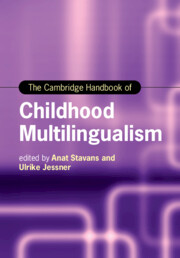Book contents
- The Cambridge Handbook of Childhood Multilingualism
- Cambridge Handbooks in Language and Linguistics
- The Cambridge Handbook of Childhood Multilingualism
- Copyright page
- Contents
- Figures
- Tables
- About the Editors
- Contributors
- Acknowledgments
- Multilingualism Is Not Bilingualism +1: An Introduction
- Part One Becoming and Being a Multilingual Child
- 1 Infant Bi- and Multilingual Development
- 2 The Development of Childhood Multilingualism in Languages of Different Modalities
- 3 Multilingualism in Early Childhood: The Role of the Input
- 4 Multilingual Education in Formal Schooling: Conceptual Shifts in Theory, Policy and Practice
- Part Two Cognition and Faculties in Multilinguals
- Part Three Family Language Policy
- Part Four Language(s) and Literacy of Multilingual Children through Schooling
- Part Five Socialization in Childhood Multilingualism
- Part Six Multilingual Children’s Landscape
- Subject Index
- Country Index
- Language Index
- References
1 - Infant Bi- and Multilingual Development
from Part One - Becoming and Being a Multilingual Child
Published online by Cambridge University Press: 18 August 2022
- The Cambridge Handbook of Childhood Multilingualism
- Cambridge Handbooks in Language and Linguistics
- The Cambridge Handbook of Childhood Multilingualism
- Copyright page
- Contents
- Figures
- Tables
- About the Editors
- Contributors
- Acknowledgments
- Multilingualism Is Not Bilingualism +1: An Introduction
- Part One Becoming and Being a Multilingual Child
- 1 Infant Bi- and Multilingual Development
- 2 The Development of Childhood Multilingualism in Languages of Different Modalities
- 3 Multilingualism in Early Childhood: The Role of the Input
- 4 Multilingual Education in Formal Schooling: Conceptual Shifts in Theory, Policy and Practice
- Part Two Cognition and Faculties in Multilinguals
- Part Three Family Language Policy
- Part Four Language(s) and Literacy of Multilingual Children through Schooling
- Part Five Socialization in Childhood Multilingualism
- Part Six Multilingual Children’s Landscape
- Subject Index
- Country Index
- Language Index
- References
Summary
The evolution and conceptualization of bi- and multilingual child language development is in focus in this chapter. I describe the history of infant bilingualism research related to the unitary vs. separated systems hypotheses. I review the effect of infant bi- and multilingualism on cognitive development. In the description of language perception, I rely on neurolinguistic findings, while in the emergence of speech I give a brief analysis of the language development of some multilingual children. I provide examples at the phonetic-phonological and lexical levels as well as evidence of multilingual awareness.
Keywords
- Type
- Chapter
- Information
- The Cambridge Handbook of Childhood Multilingualism , pp. 13 - 37Publisher: Cambridge University PressPrint publication year: 2022
References
- 3
- Cited by

